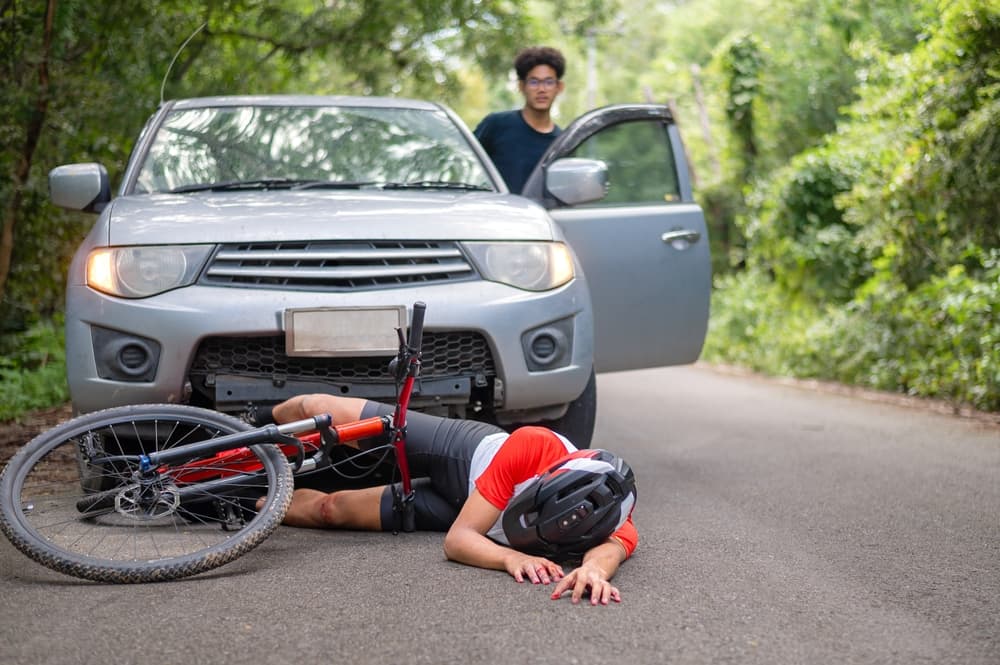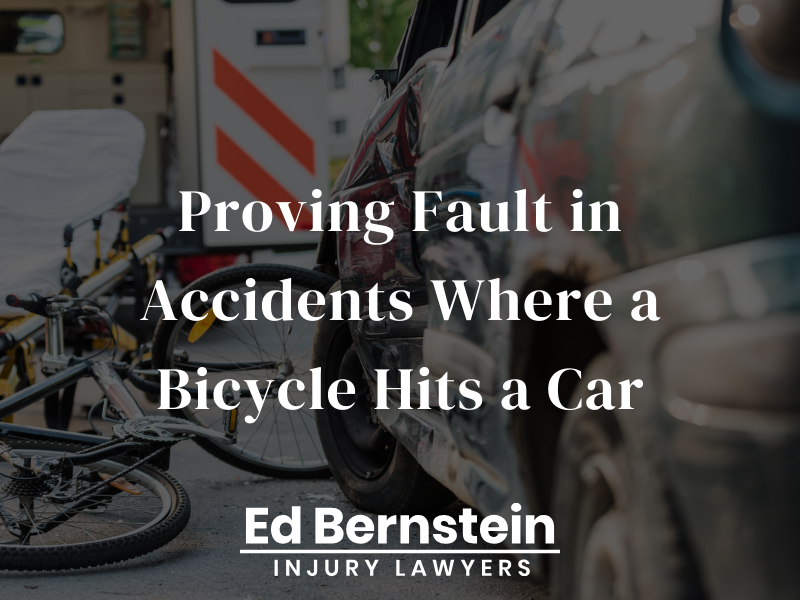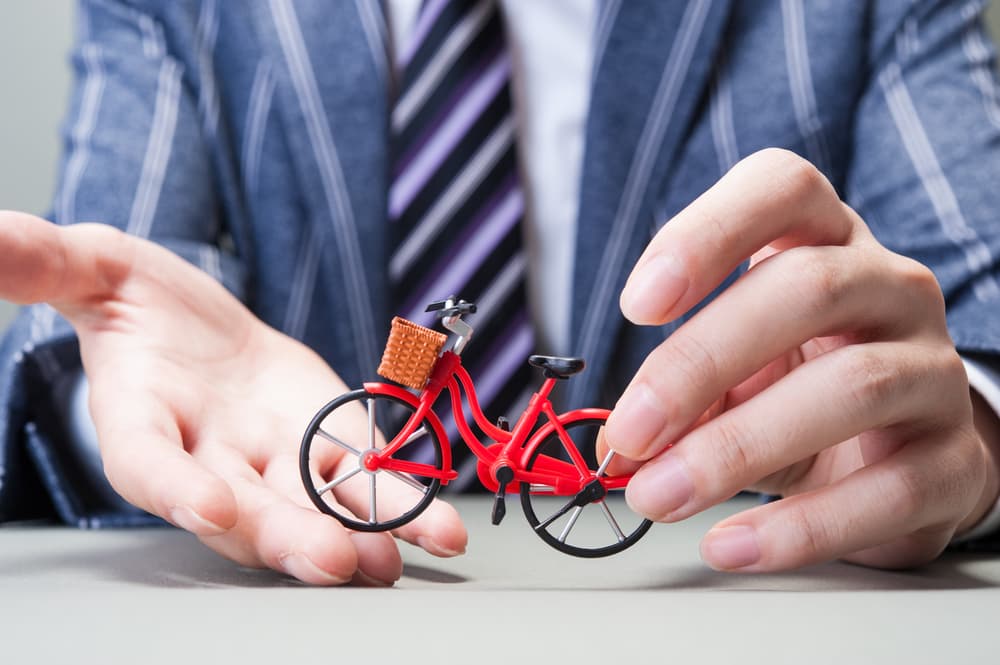For every cyclist, hitting someone’s car can be an overwhelming and stressful experience. There may be many questions on the cyclist’s mind after such an accident. One of them is, “Who is at fault if a bicycle hits a car?”
Contrary to popular belief, just because the bicycle hits the car – not the other way around – does not necessarily mean the cyclist is automatically at fault for the accident. In fact, the cyclist is often not to blame.
Below are some common scenarios where a bicyclist may hit a car and how they can seek justice and financial recovery for their injuries. If you hit a car on a bike, always consult a bicycle accident attorney about a possible claim.
Common Scenarios Where a Bicycle Hits a Car

Even the most cautious and experienced bicyclists can find themselves in a collision with a car in scenarios where they are not at fault. Some of the scenarios where a bicycle hits a car but is not found at fault include:
- Left-turn accidents. In situations where a car driver is turning left and fails to yield to an oncoming bicyclist traveling in the opposite direction, it can lead to a collision. The motorist might misjudge the cyclist’s speed or may not even see the cyclist. Typically, the driver making the turn is found at fault for failing to yield the right of way.
- Right-hook accidents. Right-hook accidents occur when a motorist turns right and strikes a bicyclist traveling in the same direction, either alongside the car or in a bike lane. Drivers may underestimate the bicycle’s speed or may not check their blind spots prior to the maneuver. In these cases, the driver is usually liable for not yielding to the bicyclist.
- Passing accidents. A collision will likely occur when a vehicle attempts to overtake a bicycle and misjudges the needed clearance. If a motorist sideswipes a bicyclist or forces them to swerve and crash, the law typically holds the motorist accountable for not passing safely at a reasonable distance.
- Dooring accidents. Dooring accidents happen when the driver or a passenger opens a car door into the path of an oncoming cyclist. Cyclists often have little to no time to react and can crash into the door, suffering severe or even life-threatening injuries. Those inside the car might be considered at fault for negligence due to their failure to check for approaching vehicles and cyclists before opening the door.
- Rear-end accidents. In rear-end accidents, a vehicle collides with the back of the bicycle. It might happen if a cyclist stops at an intersection or in traffic and a following vehicle does not stop in time. Tailgating or distracted driving can play critical roles in such accidents, and liability often falls on the motor vehicle operator.
- Backing accidents. Backing, or reversing, accidents typically occur in parking lots or driveways when a car backs into a bicyclist. Drivers must ensure the way is clear before reversing. Because bicyclists have the same right to the road as any other vehicle, a driver backing out without properly looking is likely to be found at fault.
By understanding the scenarios where a bicycle hits a car, but the cyclist is not at fault, there is an opportunity for the cyclist to advocate for fair compensation and avoid accepting a lower settlement offer.
Who Is at Fault if a Bicycle Hits a Car?
Despite the fact that bicyclists are usually the most vulnerable party in an accident involving a bicycle and a car – with cyclists accounting for 2 percent of traffic fatalities in the United States – the determination of fault in such accidents is not that straightforward. Each bicycle accident is unique, and liability is determined based on the specifics of the incident. The legal considerations in determining fault in cases where a bicyclist hits a car include:
- Negligence. One of the primary legal perspectives used to establish fault in bicycle accidents is the concept of negligence. Both bicyclists and motorists are required to obey traffic laws and exercise reasonable care. If either party fails to do so and that failure results in a collision, they may be considered negligent and found at fault.
- Right-of-way. Failure to yield the right-of-way when required can be a significant factor in determining fault. In many jurisdictions, bicycles are treated as vehicles and have many of the same rights and responsibilities on the road as motorized vehicles.
- Traffic violations. If either the cyclist or the driver of the car violated any traffic laws, such as running a red light, this can be an indicator of negligence.
- Local and state laws. Bicycling laws can vary greatly from one state to another and even from one city to another. Local statutes and ordinances might influence how fault is established in an accident involving a bicycle and a car.
Despite the common belief that you must “blame the car driver, not the bicyclist,” the justice system must examine all the facts objectively. Making general assumptions about the fault in any vehicle collision situation is a misconception without a detailed review of the evidence. The fault is assessed after considering the actions of both parties, the conditions of the road, adherence to traffic laws, and expert witness testimonies. That is why you may need the assistance of a bicycle accident lawyer when trying to prove the other party’s fault.
Elements Required to Prove Fault in Accidents Where a Bicycle Hits a Car
Determining liability in accidents where a bicycle hits a car is contingent upon several factors, and demonstrating proof of fault requires establishing certain vital elements.

1. Duty of Care
The first step in proving fault is establishing the existence of a duty of care. Every driver on the road, including bicyclists, has a legal duty to adhere to traffic laws and drive in a manner that does not put others at risk.
Example: A cyclist must obey traffic signals, yield when required, and ride in designated areas. However, if an accident occurs because a car driver opens their door without checking, thus obstructing the cyclist’s right of way, the duty of care is breached by the car driver, not the cyclist.
2. Breach of Duty
After establishing the duty of care, it must be shown that the defendant breached this duty through negligence or recklessness.
Example: If a car suddenly swerves into a bike lane, forcing the cyclist to hit the car to avoid a more serious collision, it can be argued that the driver has breached their duty of care by not respecting the cyclist’s space on the road.
3. Causation
Causation connects the breach of duty to the accident. In other words, it must be demonstrated that the defendant’s negligence directly caused the accident.
Example: Evidence here will involve showing that the car’s unpredictable maneuver (like the sudden swerve mentioned above) was the direct and proximate cause of the cyclist’s collision with the car rather than any action on the cyclist’s part.
4. Damages
Finally, there must be quantifiable damages as a result of the accident. It can include physical injury to the cyclist, emotional distress, damage to the bicycle, or other losses.
Example: Documentation of injuries sustained, repairs needed for the bicycle, medical reports, and any lost income from time off work will all contribute to the “damages” element of proving fault.
What Evidence Do You Need to Prove Fault in an Accident Where a Bicyclist Hits a Car?
The evidence collected after accidents in which bicycles collide with cars should be comprehensive. Here are the primary types of evidence that can help establish fault in a bicycle-car collision:
Eyewitness Statements
Eyewitnesses can provide crucial testimonies that detail the accident from an onlooker’s perspective. Witness statements can confirm crucial details such as:
- The traffic conditions before the impact
- The behavior of the bicyclist and the car driver
- The parties’ compliance with traffic signs and signals
Video Footage
Surveillance and recorded footage serve as unbiased and undisputable observers of the incident:
- Security cameras can reveal the positioning and movements of the bicycle and car before the accident.
- Traffic cameras offer a broader view of the intersection or street and the dynamics of the collision.
- Dashboard cameras from the involved vehicle or those of bystanders can provide direct and relevant video evidence.
Police Reports
The law enforcement officer’s account holds significant weight as these reports include observations from the police on arrival and the results of any preliminary investigation. In addition, citations in these reports, while not definitive proof of liability, may indicate which party has breached traffic laws leading to the accident.
Physical Evidence
Tangible evidence often tells the story of the event’s dynamics:
- Skid marks may demonstrate attempts to stop and the speed of the car.
- Vehicle damage can indicate points of contact and the angle of impact, which can suggest who was at fault.
- Bicycle or car damage reflects the intensity of the collision and might corroborate the cyclist’s version of the events.
Expert Testimony
Specialists interpret the evidence to reconstruct the accident. Accident reconstruction experts employ various scientific methods to analyze damage, skid marks, and more to create a narrative of how the accident may have occurred. Their expert opinion can be necessary to establish the events leading to the incident when eyewitness or video evidence is incomplete or disputed.
Collecting a combination of these types of evidence can significantly bolster a case to prove fault. It is crucial for both parties, particularly bicyclists in such scenarios, to gather as much evidence as possible immediately after the accident to prove the other party’s fault and obtain the compensation they need.
How Can a Bicycle Accident Attorney Help if You Are a Bicyclist Who Hit a Car?

Hitting someone else’s car on your bicycle might seem like a hopeless situation for you. However, just because your bicycle hits the other car does not necessarily mean you are at fault for the accident. You might still hold the driver of that car liable for the accident and obtain compensation for the medical expenses, loss of income, and other damages you have suffered.
You can do this with help from a bike accident attorney, who can assist you with the following:
- Explaining your legal rights. First and foremost, a lawyer will explain your legal rights to you. Many bicyclists are unaware of their rights on the road, especially when it comes to situations in which they hit someone’s car. Regardless of your role in the incident, you have rights that protect you, and a lawyer will make sure you understand them thoroughly.
- Proving fault in the incident. Determining fault is critical to resolving the aftermath of an accident between a bicycle and a car. Your lawyer will collect evidence, talk to witnesses, and use expert testimonies, if necessary, to help prove the car driver’s fault. Sometimes, a shared fault may be determined, which can still allow you to recover part of your damages.
- Maximizing your compensation. A lawyer will work hard to ensure you receive fair compensation for the damages and injuries sustained. It may include medical expenses, loss of work, bike repairs or replacement, and pain and suffering. A lawyer is experienced in calculating the actual cost of your accident and will strive for a settlement that covers all your needs.
- Dealing with insurance companies. Dealing with insurance companies can be overwhelming, especially when the insurer or the car driver is trying to shift the blame onto you. Insurers are often more interested in protecting their financial interests than offering fair settlements. A seasoned lawyer will handle communications with the insurance companies, counter lowball offers, and negotiate aggressively on your behalf.
- Representing you in court. If you and the insurance company cannot reach an acceptable settlement out of court, it is crucial to have a lawyer prepared to represent you during a trial. They will use their experience to present your case effectively and fight for your rights before a judge or jury. If you want to sue the car driver, you must comply with your state’s statute of limitations. This statute, which imposes a time limitation upon your right to sue, is two years from the date of injury (NRS 11.190).
If you are unsure how a injury lawyer in Las Vegas can benefit you, feel free to schedule a consultation before hiring one. Most lawyers offer free initial consultations, which means you pay nothing for a lawyer to evaluate the facts of your case.
